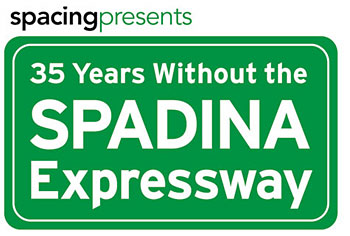
Spacing is throwing a party to honour the work of community activists that saved Toronto from the perils of superhighways. 35 Years Without the Spadina Expressway will take place Friday June 2nd at the Spadina Museum (285 Spadina Road) from 5:00-7:30pm, with speeches at 6pm. And it’s free.
We have some artist renderings of what the expressway would have looked like. Click on each photo to see a larger version. Casa Loma, Bloor and Spadina, and U of T campus would have all been reshaped if these illustrations were a reality today.
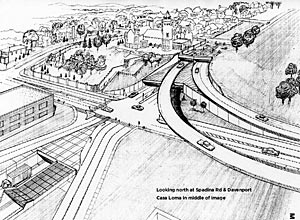

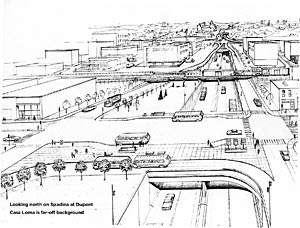
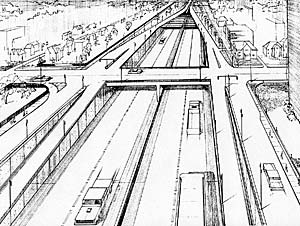
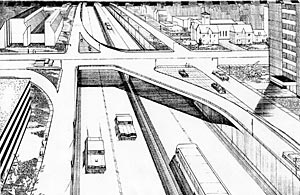
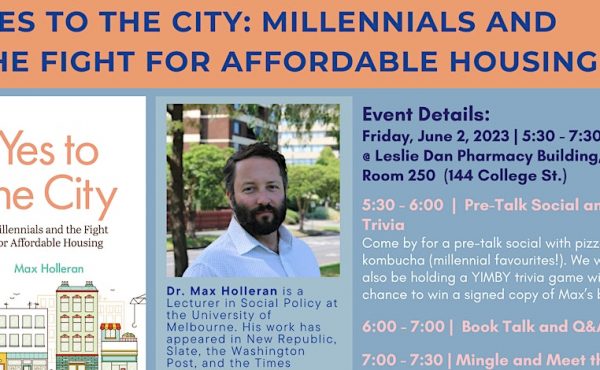
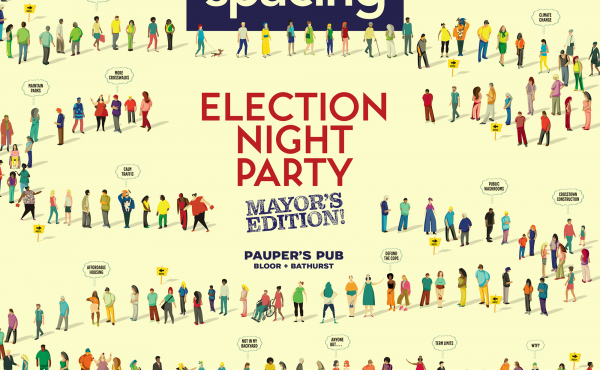
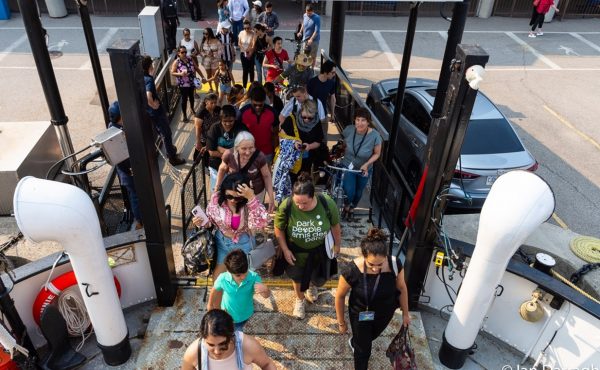
7 comments
Hey this reminds me of something…the decarie expressway in mtl. I can understand why they’d propose something like this–looks so futuristic to a fifty-something politician who grow up with the model A ford. In a strange way, would have been a bonus to toronto to have this experiment. You can see how those apartment slabs (666 spadina) were designed with this road in mind. Imagine the possibilities today redeveloping the expressway! A dense road with 10-20 storey condos, etc. Oh well, I’m glad it never happened.
Those trenches just remind me of the expressways in Detroit. I shudder to think whether beautiful neighbourhoods like the Annex would have been abandoned en masse, like the leafy inner suburbs of Detroit with such wonderful architecture left to rot.
It certainly does look futuristic, with all of those swooping lanes and vast expanses of sterile concrete.
In the Harbord image (the last of the four), I’m trying to figure out the weird, flattened S shape that centres on the intersection: is it composed of a couple of left-turn lanes that are facing each other, or what? They’re not ramps down into the trench (compare with the Bloor image, second last).
I have a feeling that the designer was a bit optimistic in thinking that the only painted line needed would be down the centre of the street. And where’s the signage? Perhaps the atomic robo-car of the future will pick up that sort of information by automatic Morse-code wireless.
Look closely at the Harbord image, and you can see the tiniest, sketched-in stick people wandering across the lethal lake of pavement. They must have accidentally wandered away from their natural habitat.
And no bike lanes, of course.
Well, you know, you’re also celebrating 35 years of squandered opportunity and gridlock, which equates to wasted fuel resources by cars and trucks idling their engines, particularly in the Don Valley Parking Lot.
You’re also going to be celebrating 35 years of urban sprawl, and the paving over of solid agricultural land to the north, east and west of the city, due to all of the businesses that abandoned the downtown core en masse to York and Peel regions.
Instead of having to come to the federal government to bail out a transit system that has seen declining riderships since the 1980s, and thus involving the rest of Canada in one city’s transportation problems, you could have had a transit corridor that incorporated *mixed-use* (to borrow some Jacobs speak) transit to make getting around and about Toronto less of a pain in the butt than it already is. It might have actually improved the flow of people, encouraged more people to come into the downtown core, and really make Toronto even more vibrant that it is by encouraging a lot more out-of-town traffic into the city.
I know I’m playing devil’s advocate here, but do people really think that killing this freeway — and the other proposed freeways, like the Crosstown — really made Toronto a better place? I mean, right now, your 401 has more traffic on it — more than the Santa Monica Freeway in Cali — probably as a result of the fact that you just can’t really get south of it, except in the very west and east ends of the city.
Do you really think that the vast majority of people were willing to give up their cars, and their ambitions to own houses in the ‘burbs, and live a communal lifestyle in downtown Toronto as Jane Jacobs imagined? Did it solve a problem, or just move it elsewhere and involve more layers of government than you can shake a stick at? I wonder.
It would have meant less people on transit and more people in cars. More roads convinces people that they can drive more places. I was in LA a few weeks ago and it was sick how many highways they had. And each neighbourhood/city was divided by superhighways.
The problem is not that we don’t have enough highways, its that we have not done enough to make using transit a vaible option. The only reason so many people drive on the 401 is that there is no commuter train that travels along it to aleviate congestion.
Yes we have problems with traffic but it is not becuz we didn’t build highways — we didn’t build other options instead.
And yes, killing those highways did make the city better. There are wastelands around our superhighwys now — and our most vibrant ‘hoods — the annex, Chinatown, Kensington, Queen W, the redeveloped King W, all would have been a victim of this highway.
And then what the other highways would havew done to Riverdale and and the hood’s south of the Danforth, the Beaches, if the Scarborough freeway was built.
Interesting. *However*, I understand transit *has* been declining in Toronto since the 1980s, so I’m not entirely sure I buy the “more roads = less riders on transit” agrument.
KDC has the best, most realistic take on this whole “yay for no highways in Toronto” page.
The only thing killing this highway did was steadily alienate the downtown core and boost urban sprawl. Anyone who thinks withholding highway infrastructure will magically make people make use of a stagnant transit system are deluded.
You can make up imaginary scenarios of destruction of various neighborhoods until the cows come home, but with the hindsight of history we can see the subsequent results to Toronto with frightening clarity: a city that has totally squandered its possibilities, due to the crowing of short-sighted NIMBYS and activists.